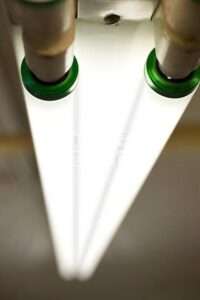While the initial cost of LED lights is often a concern for many gardeners and growers, the benefits of using LED lights to grow plants is worth considering.

Few climates are blessed with the sun that meets all of their growing needs year round. Even in the best-designed greenhouses, a significant percentage of solar radiation is blocked by the building’s structure and the glazing on the glass before the light reaches the plants. In regions with shorter growing seasons or for growers doing significant indoor growing, this presents a larger problem.
Benefits of using LED lights to grow plants
Many growers are looking for grow-light options that will improve upon the light given off by fluorescent or HPS (high-pressure sodium) lights. Fortunately, LED lights meet all of the growing needs a plant has while reducing growers’ costs over time.
Lower cost
While using LED lights to grow plants is typically initially more expensive to buy than other light options, it doesn’t take long for LED lights to pay for themselves. Over the course of their lifespan (which is also significantly longer than fluorescent lights), LED lights are noticeably cheaper. LED lights are over 60% more efficient than HPS lights and also offer more lighting level control options – making them even more efficient.
Less water
Because of the diodes used to illuminate LED lights, LED lights produce virtually no heat. This is a huge advantage to growers who regularly have to account for the amount of water lost to grow lamps when they are caring for their plants. Likewise, if regulating the temperature in a growing space is a concern, using LED lights will make climate control much more reliable and consistent.
Larger plants
Perhaps most importantly, LED lights help growers produce larger plants. With LED lights, growers are able to customize the amount of light given to plants based on the plants’ need, rather than having to choose between off and on as with other lighting options. By being able to customize the amount of light plants are receiving, growers have been able to grow larger plants that are getting the correct amount of nutrients they require.
